Bhadrakali Temple, Haryana.
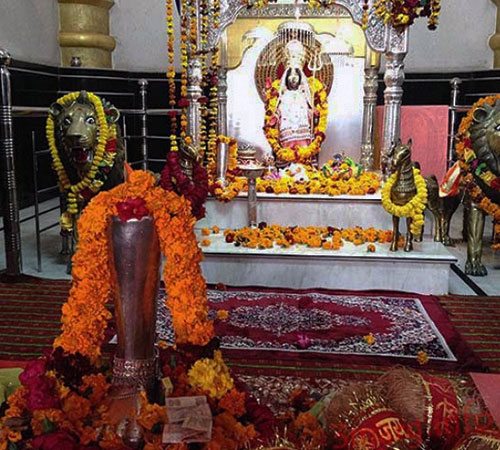
- : Jhansa Road, Opposite Jindal Park, Kuber Colony, Thanesar, Kurukshetra District, Haryana, Pin – 136118, India..
- : Nearest airport: Chandigarh (94.5 km); nearest railway station: Kurukshetra Junction (3 km)..
- : 5.30 am to 8 pm (summer) and 6.15 am to 7.30 pm (winter).
- : 1 to 2 hours.
- : Navratri Festival (October to March)..
- : Hotels are available in close proximity to the temple..
 Basic info
Basic info
One of the 51 Shakti Peethas of India, Shaktipeeth Shri Devikoop Bhadrakali Mandir is an ancient and significant temple in the district of Kurukshetra. As per the legends, the right anklet of Goddess Sati fell here in a well and Goddess Shakti or Kali is worshipped here in the form of Bhadrakali. This temple is also called Savitripeeth, Devikoop, and Kalikapeeth. This place also holds significance in the great Hindu epic of Mahabharata. As per the common belief, the Pandavas accompanied by Lord Krishna worshipped Goddess Durga here before and after the battle of Kurukshetra. People also believe that the ‘Mundan’ (hair removing) ceremony of Lord Krishna and his brother Balaram was performed here.
After the fulfillment of their wishes, the devotees offer miniature terracotta and metallic horses to the Goddess in gratitude as per the tradition. Idols of many other gods and goddesses are also present in the temple. The 9-day Navratri Festival is celebrated in this temple in a grand way. On Saturdays and during the Navratri Festival, the temple remains open till 9 pm.
Brahma Sarovar, Haryana.
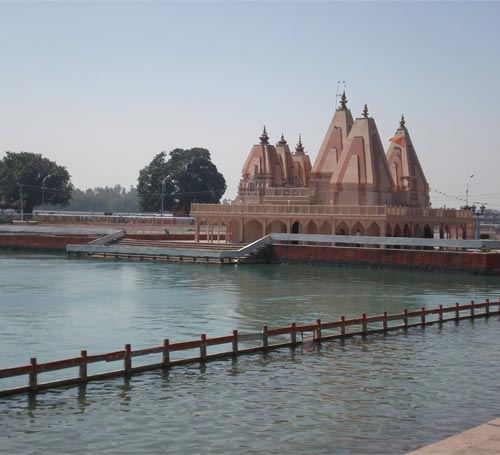
- : Brahma Sarovar Area, Thanesar, Haryana, Pin – 136118, India..
- : Nearest railway station: Thaneswar City– 1 Km; nearest airport – Chandigarh International Airport – 98.8 km..
- : Sunrise to sunset, all days in a week.
- : 2 to 3 hours.
- : September to March.
- : Many hotels and lodges are available nearby..
 Basic info
Basic info
Brahma Sarovar is a man-made lake, located in Thanesar, Haryana. The pond is 3600 feet long, 1500 feet wide, and 45 feet deep. The word ‘Sarovar’ refers to a lake or pond. Asia’s largest artificial lake is named so because it is believed that from the land of Kurukshetra, Lord Brahma, the creator of the universe started His creation. According to Mahabharata, it is said that under the water of this lake, Duryodhana hid himself in the last day of Kurukshetra war.
Every day during the sunrise and sunset, the Brahma Sarovar is worshipped. A beautiful temple and a large statue of Lord Shiva are situated at the center of the lake, which can be reached via a bridge. Inside this temple, there are two large chariots made of black stone - one was Lord Arjun’s and the other one was of Lord Krishna’s. The main Sarovar complex also has two famous temples - Draupadi Koop and Mata Katyayni Devi Temple. During the solar eclipse, many pilgrims come here to pray to the Sun God. The festival of Gita Jayanti, the birth of Gita is celebrated in the Brahma Sarovar in the month of November and December each year.
Jal Mahal, Haryana.
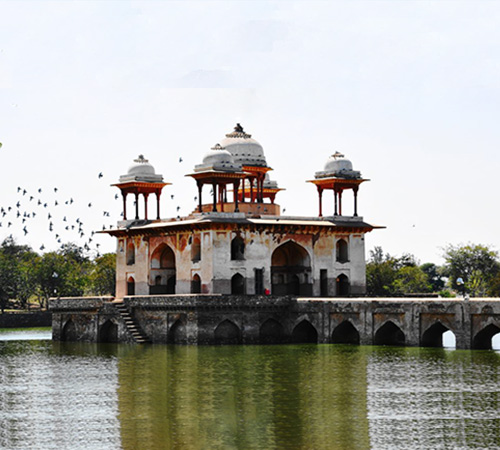
- : Mohalla Purani Mandi, Narnaul, Haryana, Pin – 123001, India..
- : Nearest railway station: Narnaul – 3.5 Km; nearest airport – Indira Gandhi International Airport, New Delhi – 144.1 km..
- : 6 am to 6 pm, all days in a week.
- : 1 to 2 hours.
- : Best season to visit is September to March..
- : Different types of hotels and lodges are available nearby..
 Basic info
Basic info
The Jal Mahal, also known as the “Khan Sarovar” and “Water Palace”, surrounded by an artificial lake, is located in Narnaul, Haryana. This huge man-made lake and palace were built in between 1591 AD to 1596 AD, by the Governor of Narnaul and the army commander Shah Quli Khan, of the Great Akbar.
The lake and fort complex spread over 11 acres of area. There is a large entrance gate, which is made of red sandstone and Himalayan wood, was designed in Mughal architectural style. There is a concrete bridge to reach the main palace over the lake. Inside the palace, there are four separate chambers placed in the four different corners of the main chamber. The palace was constructed using lime and stone, the color of the inside walls and ceiling is golden and are embellished with different paintings, photographs, and geometric structures of that period.
Kingdom of Dreams, Haryana.
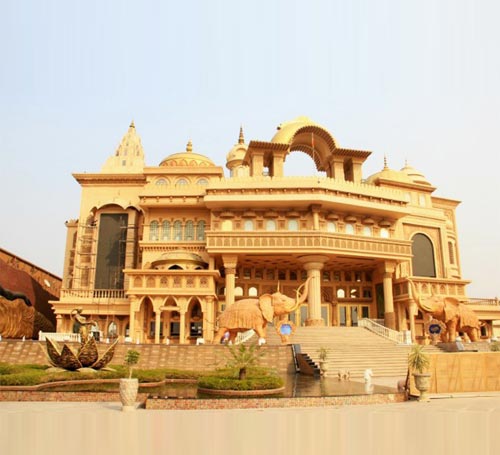
- : Auditorium Complex, Near IFFCO Metro Station, Sector 29, Gurugram, Haryana, Pin - 122001, India..
- : Nearest railway station: IFFCO Chowk Metro Station – 0.6 Km; nearest airport – Indira Gandhi International Airport – 14.1 km..
- : Show timing between 12.30 PM to 12 AM every day, (Monday closed).
- : Depends on show timing and duration, around 2 to 3 hours..
- : can be visited throughout the year..
- : Many hotels are available nearby..
 Basic info
Basic info
One of the most famous tourist attractions around Delhi, the Kingdoms of Dreams (KOD), located in Sector 29, Gurgaon, is India’s first live entertainment leisure spot, which offers limitless pleasure and fun. It displays the perfect and complete combination of different Indian culture, traditions, arts, and crafts in a single complex. This iconic entertainment auditorium was inaugurated on 29th January 2010, by the former Chief Minister Mr. Bhupinder Singh Hooda and opened for public on 18th September 2010.
This dream building is run by the Great Indian Nautanki Company associated with Apra Group and Wizcraft. On 19th September 2010, Mr. Shah Rukh Khan was declared as the Global Ambassador of the KOD. The auditorium comprises around 6 acres area and the project cost was around 200 crores. The main auditorium has three parts – 864-seater auditorium “Nautanki Mahal” designed like a regal palace, 350-seater “Showshaa Theater” for Indian mythological shows, and Culture Gully having 1 lakh square feet area for representing the Indian culture.
Lohagarh Farms, Haryana.
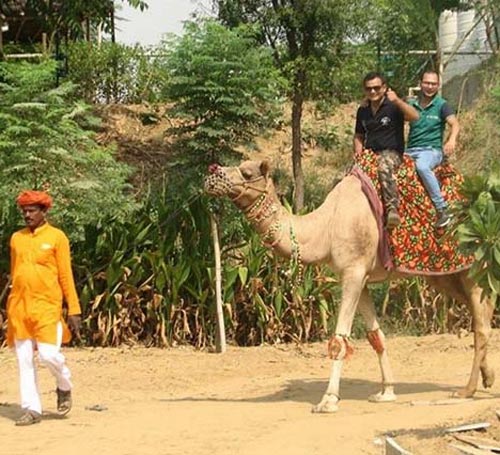
- : Sohna Road, Gairatpur Baas, Near Badshahpur, Gurugram, Haryana, Pin – 122101, India..
- : Nearest airport: New Delhi (37.2 km); nearest railway station: Sector 55-56 Subway Station (20.1 km)..
- : Sunday to Saturday, from 9 am to 6 pm.
- : 4 to 6 hours..
- : September to December..
- : Hotels and other accommodation facilities are available nearby..
 Basic info
Basic info
To experience the flavor of rural India at its best, a visit to the Lohagarh Farms becomes a must. Located at the foothills of the Aravali Ranges, this farm portrays the beautiful picture of an idyllic Indian rural life, which is a sharp contrast to the maddening urban life of the present day. Tourists visit here to de-stress their minds and to spend some cherishable moments in the serenity of nature. This place is famous as a picnic spot.The tourists get the opportunity to indulge in various fun-filled activities in the farm like camel ride, bullock cart ride, etc. and also enjoy various rural customs and practices like pottery, mehndi, charkha, chakki, mud bath, tube well bath, dairy and agricultural activities, and a lot more. You can also participate in various rural sports and adventure sports. Different types of ethnic cuisines are served here which are a treat to the taste buds. This rustic farm is a great place to teach your children all about the rural lifestyle in a simple and enjoyable way. So, visit Lohagarh Farms, experience the country life, and come close to nature.
Morni Fort: The Golden Bastions, Haryana.
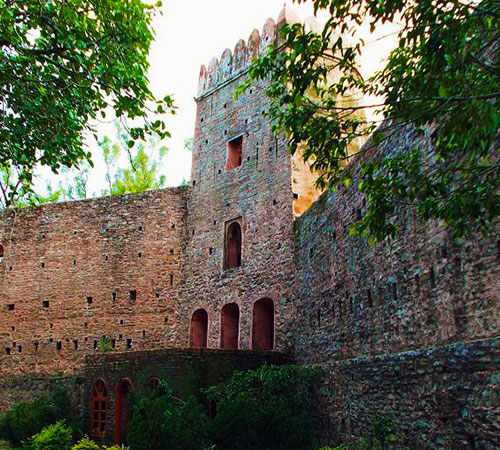
- : Main Road Panchkula to Badiyal Road, Bhoj Balig, Panchkula, Haryana, Pin – 134205, India..
- : Nearest railway station: Kalka – 36 Km; nearest airport – Chandigarh International Airport – 52.6 km..
- : 9 AM to 5 PM, all days in a week.
- : 1 to 2 hours.
- : Best season to visit - September to March..
- : Hotels and other lodging facilities are available nearby..
 Basic info
Basic info
The famous historical fort in Haryana, the Morni Fort, surrounded by the Himalayan greenery, is located at the top of the Morni Hills in Panchkula. The Morni Hill, around 1200 meters high, is a very popular destination among the travelers as it is the only hill station in Haryana with a lot of scopes for sightseeing. The fort was built around the 17th century using hilly stones and red bricks. The building complex has a huge main gate on the eastern side and four towers at different corners.
In 1977, the ownership of the fort was taken by the Haryana Forest Department and a bird breeding center was formed, considering the Himalayan wildlife environment. A brightly colored Shiva Temple is also located in the eastern side of the fort complex, beside the main gate. Other nearby tourist attractions are Thakur Dwar Temple, Bhuri Singh Deota Temple, Morni Fort Museum, Masoompur Fort, Garhi Kotaha Fort, etc. Also, this Morni Fort complex and the surrounding area is popular as a picnic spot.
Pinjore Gardens, Haryana.
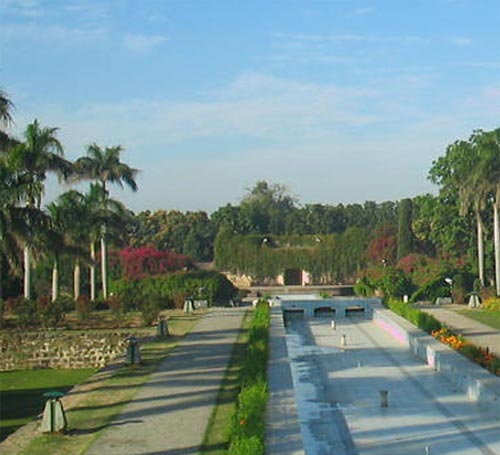
- : Ambala-Shimla Highway, Pinjore, Haryana, Pin - 134102. India..
- : Nearest railway station: Kalka – 7.1 Km; nearest airport – Chandigarh International Airport – 33.3 km..
- : 7 AM to 11 PM, all days in a week.
- : 2 to 3 hours.
- : September to March.
- : Luxury and budget hotels and lodges available..
 Basic info
Basic info
The Yadavindra Gardens, previously known as Pinjore Gardens is located on the Ambala-Shimla Road, in the city of Pinjore, Haryana. This historically significant garden is the perfect example of Mughal Garden architecture. It was built in the early 17th century by a Mughal emperor and later was reconstructed by the Jat Sikh rulers of Patiala Dynasty. The garden was built in the Himalayan hilly area for the recreation of the Mughal rulers during the hot summer months. The architect, who designed this garden was Muzaffar Hussain, the foster brother of Aurangzeb. Later in 1775, Maharaja Amar Singh, the king of Patiala bought it from Jagat Prakash, King of Sirmur State. The last Maharaja of this dynasty, Yadavindra Singh (1914-74) made many renovations and changes in the garden.
The garden has a palace near the main entrance, built in Mughal style, called “Shish Mahal” and beside this, an airy palace is situated called “Hawa Mahal”. Also, there are two more palaces, the “Rang Mahal” or the painted palace and “Jal Mahal”, also called the Palace of Water. Other tourist attractions are Pinjore Garden Zoo, Heritage Train, and fairs and festivals like Baisakhi Festival, Mango Fair, Heritage Festival, etc.
Raja Nahar Singh Palace, Haryana.
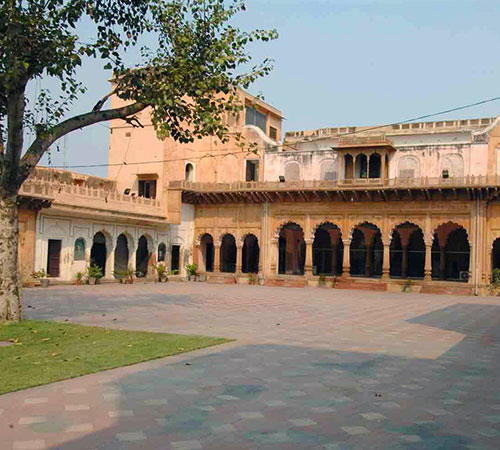
- : Ambedkar Chowk, Ballabhgarh, Faridabad, Haryana, Pin – 121001, India..
- : Nearest railway station: Ballabh Garh – 1 Km; nearest airport – Indira Gandhi International Airport, New Delhi – 43 km..
- : 9 AM to 11 PM, every day of the week.
- : 1 to 2 hours.
- : The ideal season - September to March..
- : The palace itself is a heritage hotel and many other hotels are available nearby as well..
 Basic info
Basic info
Nahar Singh Mahal or Raja Nahar Singh Palace, also known as Ballabhgarh Fort Palace, is located in Ballabhgarh village, Faridabad, Haryana. The construction work was started by Raja Balram Singh in 1739 AD, and later in 1850, Raja Nahar Singh completed the rest of the construction work. The beautiful palace has two surviving minarets, ornamented pavilions, and chambers designed with colorful paintings and magnificent sculptures. Also, there are two huge halls, called Darbar-e-Aam, the hall for public audience, and the other one is Rang Mahal decorated with chhatris.
In the recent past, this palace was declared as a heritage property and is now managed by the Haryana Tourism Department. In 2003, the Palace has been reconstructed and developed as a hotel and restaurant keeping the historic architectural design intact, offering comfortable accommodation in a traditional and royal environment. The main tourist attraction of this palace is Kartik Festival, celebrated in the month of November each year since 1996, organized by the Haryana Tourism Department. Other nearby tourist attractions are Dhauj Lake, Surajkund Lake, Aravalli trekking, Baba Farid Tomb, and many more.
Sultanpur National Park, Haryana.
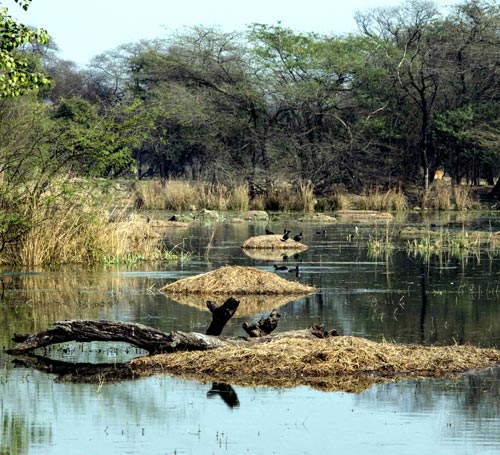
- : Gurgaon Farukh Nagar Road, Sultanpur, Gurugram, State - Haryana, Pin – 122006, India..
- : Nearest railway station: Sultanpur Kaliawas Halt – 2.7 Km; nearest airport – Indira Gandhi International Airport – 33.9 km..
- : 8 AM to 6.30 PM every day except Tuesday.
- : 2 to 3 hours..
- : Best season - October to March..
- : There is no dearth of quality hotels in Gurugram..
 Basic info
Basic info
The Sultanpur National Park, previously known as Sultanpur Bird Sanctuary, is a very popular wildlife park situated in Sultanpur in Gurgaon, Haryana. Winter is the best season to visit this national park as many migrated birds come here from different parts of the world. In 1972, the former Chief Minister of Haryana, Mr. Bansi Lal inaugurated this Bird Sanctuary and later on 13th July 1989, the sanctuary got upgraded to a National Park.
The national park covers around 1.43 square kilometer area. Approximately 250 species of birds are seen here, among them some are migratory like Siberian Cranes, Ruff, Common Teal, Northern Pintail, Yellow Wagtail, Gadwall, etc. and some are resident birds like Weaver Bird, Magpie Robin, Common Hoopoe, Gary Francolin, etc. Also, it has different types of flora and fauna. The park is very popular locally as a well-facilitated picnic spot. Also, there are four watchtowers, an education and research center, a central library, auditorium for movies and slides shows, and a birds’ photo gallery as tourist attractions.
Surajkund Mela, Haryana.
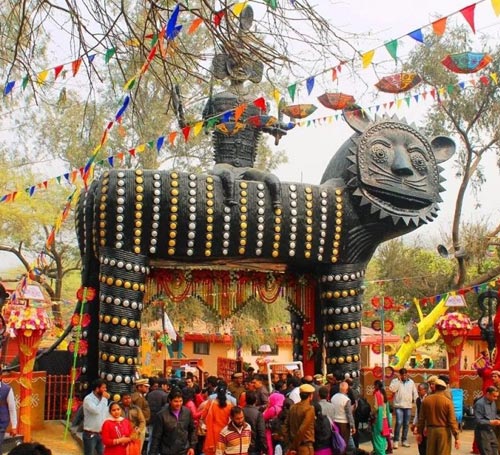
- : Suraj Kund Road, Lakewood City, Surajkund, Faridabad, Haryana, Pin – 121010, India..
- : Nearest airport: Indira Gandhi International Airport (24.7 km); nearest railway station: Faridabad (10.5 km)..
- : 10.30 am to 8.30 pm (1st to 17th February)
- : 2 to 3 hours..
- : February, during the festival..
- : Both luxury and budget accommodation options available..
 Basic info
Basic info
The 10th-century ancient water reservoir known as Surajkund (meaning ‘Lake of the Sun’) is a popular tourist attraction in the state of Haryana. Located in the Southern Delhi Ridge with the mighty Aravallis on the backdrop, this man-made reservoir has an extensive embankment that looks like an amphitheater, which is semi-circular in form. In the 10th century, this kund was built by a ruler of Tomar Dynasty, King Suraj Pal.
An annual fair is held here named Surajkund International Craft Mela, which is a grand event in the entire region. This is an art and crafts fair, where you will get to witness varied forms of vivid art and crafts, dance, music, cultural programs, etc. The colorful shops and a marvelous assortment of items will give you an unforgettable visual treat. You will also get to taste various mouth-watering ethnic cuisines that are served at the food corners in the fair.
This fair was started in 1987 and since then, has been serving as a fantastic platform for the highly skilled craftsmen and artisans of India and the SAARC Nations for showcasing their talent and hard work. It is a golden opportunity for the tourists to learn more about the traditional art and culture of India and take home some of the finest specimens of the same.








